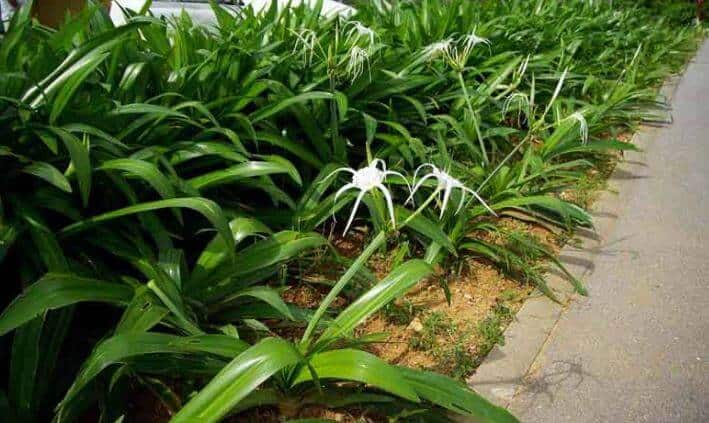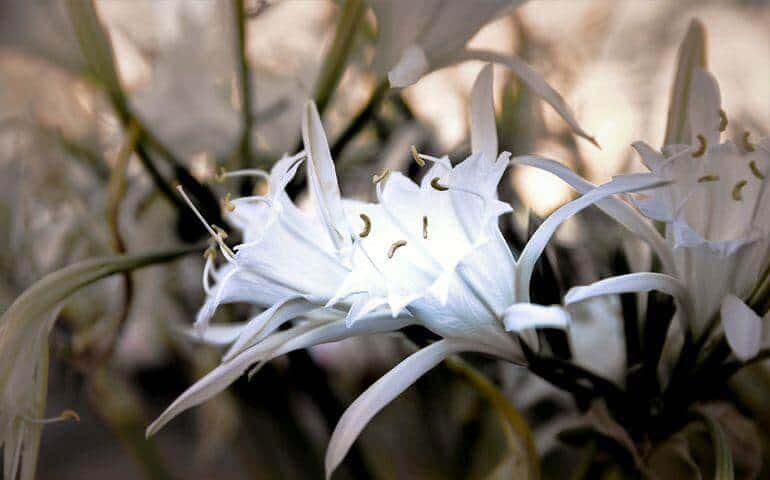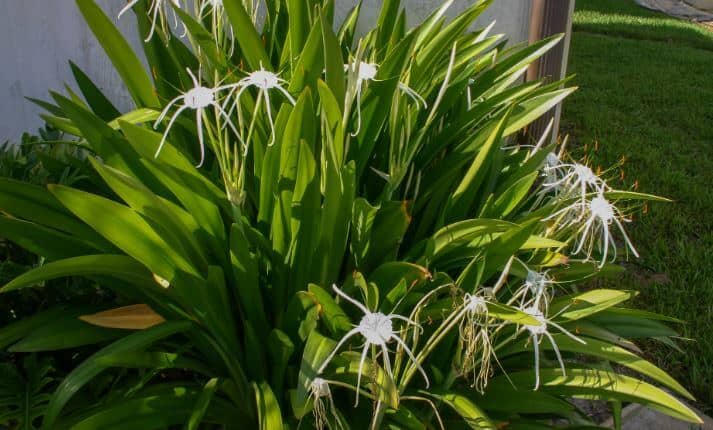Last Updated on January 8, 2023 by a Friendly Gardener
If you are not familiar with the Beach Spider Lily, it’s certainly worth getting to know this fascinating bulb plant. The Beach Spider Lily, as the name implies, likes an aquatic environment. Tropical and subtropical natives, they love the water, the sun, and a bit of sand. It is an easy-to-care-for perennial herb plant that features some of the most unique blooms in the plant world.
A native of Central America, Mexico, Colombia, Venezuela, and parts of Brazil and Peru, this plant is appreciated above all for its flowers. The characteristic blooms appear as though they are spiders that crawl across the plant, and they emit a lovely vanilla fragrance. So, if you’re looking for an original decorative plant that scents the air, consider this amazing plant.

Botanically known as the Hymenocallis littoralis, it is a member of the Amaryllidaceae family known for members producing spectacular flowers. It requires a generously sized container of at least a half-gallon when young. As it grows it will communicate that it needs a new pot by breaking through the old one. Ample water and sunlight, along with a particular blend of soil are needed. When the environmental conditions are correct, your Beach Spider Lily can grow to approximately 2 to 3 feet in length. Once it blooms, it may extend another foot.
Individual bulbs will grow multiple stems featuring strap-like foliage. Leaves can arc as much as 2 feet as well. Towards mid-summer, white blossoms will appear containing 5-to-7-inch tube-shaped capsules. These capsules then open into beautiful white flowers. As many as eight flowers can bloom on a single stalk. Flower edges produce cascading slim tepals contributing to the spider appearance.
Beach Spider Lilies require a rest period annually. Once blooms are spent and have fallen toward the end of August or early September, reduce water, light, and interrupt feeding for a minimum of three weeks to allow your plant to rest.
Beach Spider Lilies Plant Care
Soil

Appreciative of loamy soil, a basic potting soil can be used, but it needs to be mixed at a 1 to 1 ratio with pumice or bark. You can also opt for 3 parts potting soil to one part sand. It needs to be organically rich and well-draining. Soil pH should be acidic to neutral and measure between 5 and 7.5 for the plant to remain healthy. Container size is important, even for young specimens, so begin with at least a half-gallon-sized pot. The beach Spider Lily does not tolerate salt in the soil well.
Light
The Beach Spider Lily enjoys full sun. It can thrive in partial shade as long as it has the possibility to access sufficient light for its growth. This means getting several hours daily of filtered bright light when cultivated indoors. Indoor plants can be moved to an outside spot during the summer.
Water

This plant thrives in an aquatic environment so it will need relatively wet conditions year-round. Be generous when watering during the plant’s growing season.
You can begin a Spider Lily bulb in water, but once sprouting begins, they need to be moved to soil. The soil must be maintained evenly moist but must not be allowed to become soggy. If you keep a dish underneath your plant’s pot, never leave standing water.
Reduce watering during the winter when growth slows yet still maintains moistness. When new growth begins, resume normal watering.
Humidity
Ideally, humidity for the Beach Spider Lily should measure between 40% and 50%. The beach Spider Lily does very well in normal home humidity if the soil is kept moist. If the soil bed dries out, it’s important to mist leaves and blooms to contrast the risks of dehydration, or to raise humidity levels in the immediate area of the plant. Do this with a space humidifier, a water-filled receptacle, or a pebble tray if necessary.
Temperature
This plant likes warmth. A room temperature of 70° to 85°F. is recommended during the growing season with a minimum temperature of 60°F. during winter rest. Ideally, the temperature should never drop lower than 55°F at night.
Your Beach Spider Lily may be able to withstand temperatures that drop into the 40s F. but no colder. They do not tolerate frost. When exposed to frost, they die back to the bulb, so overwintering is recommended for outdoor lilies or for container houseplants kept outside on a deck or porch. They are not heat or drought-tolerant.
Feeding

Beach Spider Lilies can be fed every two weeks during the growing season in spring and summer. A balanced fertilizer should be diluted to half-strength. Seaweed-based fertilizers have proven to offer good results.
Pruning
Pruning is not required for these plants. They are also non-invasive.
Potting and Repotting a Beach Spider Lily
Beach Spider Lilies will need to be repotted approximately every four years or so. They only require repotting when they become overcrowded, and often they will break the pot if necessary. They enjoy being a little bit rootbound.
Beach Spider Lily Propagation

Propagation of the Beach Spider Lily is achieved through the division of bulbs. Offsets that grow from the parent plant can be separated in the springtime. Once separated, pot them in individual containers but water your new bulbs sparingly until you see new growth or for their first month separated from the parent plant.
Beach Spider Lily Problems
The principal problem encountered with a Beach Spider Lily is a lack of flowering or blooms that are tiny. Should your plant exhibit difficulty in flowering, organize a rest period for it. Reduce watering, only maintaining soil evenly damp and place it in a shaded or darkened location. Do not fertilize. This rest period should last about a month.
If your plant continues to have difficulty flowering, verify if the soil is sufficiently moist. Another reason for refusal to flower can be attributed to too little sunlight. If you have moved your plant outside for a spell, check to see that snails or slugs are not present and munching on leaves. Remove any you find immediately.
While not particularly susceptible to pest infestations, they can be visited by caterpillars, mealy bugs, and the aforementioned snails or slugs. These should all be removed manually. Mealy bugs can be removed with a cotton ball dipped in alcohol.
Toxicity
Beach Spider Lilies are not toxic to house pets.

